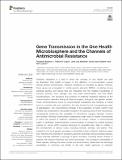Por favor, use este identificador para citar o enlazar a este item:
http://hdl.handle.net/10261/208704COMPARTIR / EXPORTAR:
 SHARE SHARE
 CORE
BASE CORE
BASE
|
|
| Visualizar otros formatos: MARC | Dublin Core | RDF | ORE | MODS | METS | DIDL | DATACITE | |

| Campo DC | Valor | Lengua/Idioma |
|---|---|---|
| dc.contributor.author | Baquero, Fernando | es_ES |
| dc.contributor.author | Coque, Teresa M. | es_ES |
| dc.contributor.author | Martinez, José-Luis | es_ES |
| dc.contributor.author | Aracil-Gisbert, Sonia | es_ES |
| dc.contributor.author | Lanza, Val F. | es_ES |
| dc.date.accessioned | 2020-04-22T20:53:29Z | - |
| dc.date.available | 2020-04-22T20:53:29Z | - |
| dc.date.issued | 2019-12 | - |
| dc.identifier.citation | Frontiers in microbiology 10: 2891 (2019) | es_ES |
| dc.identifier.uri | http://hdl.handle.net/10261/208704 | - |
| dc.description.abstract | Antibiotic resistance is a field in which the concept of One Health can best be illustrated. One Health is based on the definition of communication spaces among diverse environments. Antibiotic resistance is encoded by genes, however, these genes are propagated in mobile genetic elements (MGEs), circulating among bacterial species and clones that are integrated into the multiple microbiotas of humans, animals, food, sewage, soil, and water environments, the One Health microbiosphere. The dynamics and evolution of antibiotic resistance depend on the communication networks linking all these ecological, biological, and genetic entities. These communications occur by environmental overlapping and merging, a critical issue in countries with poor sanitation, but also favored by the homogenizing power of globalization. The overwhelming increase in the population of highly uniform food animals has contributed to the parallel increase in the absolute size of their microbiotas, consequently enhancing the possibility of microbiome merging between humans and animals. Microbial communities coalescence might lead to shared microbiomes in which the spread of antibiotic resistance (of human, animal, or environmental origin) is facilitated. Intermicrobiome communication is exerted by shuttle bacterial species (or clones within species) belonging to generalist taxa, able to multiply in the microbiomes of various hosts, including humans, animals, and plants. Their integration into local genetic exchange communities fosters antibiotic resistance gene flow, following the channels of accessory genome exchange among bacterial species. These channels delineate a topology of gene circulation, including dense clusters of species with frequent historical and recent exchanges. The ecological compatibility of these species, sharing the same niches and environments, determines the exchange possibilities. In summary, the fertility of the One Health approach to antibiotic resistance depends on the progress of understanding multihierarchical systems, encompassing communications among environments (macro/microaggregates), among microbiotas (communities), among bacterial species (clones), and communications among MGEs. | es_ES |
| dc.description.sponsorship | This work was supported by grants AC16/00043 ST131S, JPIAMR16-AC16/00036, and JPIAMR16-AC16/00039 (JPIonAMR-Third call on Transmission, ST131TS project), InGEMICS-CM, funded by Comunidad de Madrid (Spain) and European Structural and Investment Funds; and the Spanish Ministry of Economy and Competitivity (Grant No. BIO201783128-R, to J-LM), CIBER (CIBER in Epidemiology and Public Health, CIBERESP; CB06/02/0053), integrated in the Spanish 2013–2016 and 2017–2020 R+D+i State Plans and co-funded by Instituto de Salud Carlos III and the European Regional Development Fund(ERDF,“Away to achieve Europe”). | es_ES |
| dc.language.iso | eng | es_ES |
| dc.publisher | Frontiers Media | es_ES |
| dc.relation.isversionof | Publisher's version | es_ES |
| dc.rights | openAccess | es_ES |
| dc.subject | accessory genes | es_ES |
| dc.subject | gene flow channels | es_ES |
| dc.subject | microbiome merging | es_ES |
| dc.subject | one health | es_ES |
| dc.subject | resistance genes | es_ES |
| dc.title | Gene Transmission in the One Health Microbiosphere and the Channels of Antimicrobial Resistance. | es_ES |
| dc.type | artículo | es_ES |
| dc.identifier.doi | 10.3389/fmicb.2019.02892 | - |
| dc.description.peerreviewed | Peer reviewed | es_ES |
| dc.relation.publisherversion | http://doi.org/10.3389/fmicb.2019.02892 | es_ES |
| dc.identifier.e-issn | 1664-302X | - |
| dc.relation.csic | Sí | es_ES |
| oprm.item.hasRevision | no ko 0 false | * |
| dc.contributor.orcid | Martínez, José Luis [0000-0001-8813-7607] | es_ES |
| dc.identifier.pmid | 31921068 | - |
| dc.type.coar | http://purl.org/coar/resource_type/c_6501 | es_ES |
| item.openairetype | artículo | - |
| item.fulltext | With Fulltext | - |
| item.openairecristype | http://purl.org/coar/resource_type/c_18cf | - |
| item.cerifentitytype | Publications | - |
| item.grantfulltext | open | - |
| item.languageiso639-1 | en | - |
| Aparece en las colecciones: | (CNB) Artículos | |
Ficheros en este ítem:
| Fichero | Descripción | Tamaño | Formato | |
|---|---|---|---|---|
| MARTÍNEZ, José Luis.pdf | Artículo principal | 1,97 MB | Adobe PDF |  Visualizar/Abrir |
CORE Recommender
PubMed Central
Citations
37
checked on 03-may-2024
SCOPUSTM
Citations
67
checked on 07-may-2024
WEB OF SCIENCETM
Citations
58
checked on 27-feb-2024
Page view(s)
126
checked on 12-may-2024
Download(s)
157
checked on 12-may-2024
Google ScholarTM
Check
Altmetric
Altmetric
Artículos relacionados:
NOTA: Los ítems de Digital.CSIC están protegidos por copyright, con todos los derechos reservados, a menos que se indique lo contrario.
